LATE & EARLY SEASON FISHING AT DUPUY'S SPRING CREEK (part 6)
Satoshi Yamamoto - Apr 08, 2013
| Sysadmin Note |
| Part 5 can be found here |
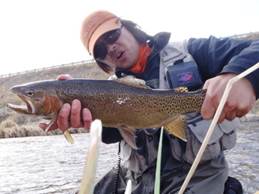
One of best and most handsome rainbows!
Rainbow Time: Winter usually loosens its grips in March. From early March, rainbows are coming from the Yellowstone River into DePuy's for spawning. This time it's brown trout that follow behind and devour eggs. This is another period one can encounter some of biggest trout of the year. Spawning run continues till April. Trout population in the creek is back to as thick as October. Midges and spring BWO hatches are also expected. New fishing season in Paradise Valley is open, yet only a few dedicated anglers are out there.
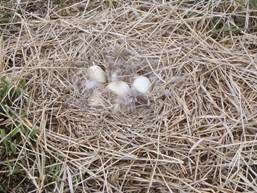
Goose nest along DePuy's
Understanding Rainbows' Spawning: As days warm up and we enjoy spring fishing, what we think next is runoff, which is usually predicted in early May. Oh, what a mother nature is. Rainbow trout must have been evolved to accompany that. If majority of them would ever spawn in Yellowstone River in March or April, most of their eggs and hatchlings would be washed away immediately by turbid water. That must be the reason that more rainbows run up to the creek in spring more than browns do in the fall (NOTE: In the fall, many browns spawn in Yellowstone River without running up to DePuy's. By runoff, hatchlings would grow up enough to swim around and hold at soft spots in Yellowstone River). Indeed rainbows make redds and spawn anywhere they think suitable at DePuy's. You will also see ducks and geese make nests and lay eggs along DePuy's and Yellowstone River at this time of the year. By runoff, chicks are strong enough to follow their parents and swim over turbid waters. While fall is a glorious time to end the season, spring is indeed the time to feel the breath of a new season and lives.
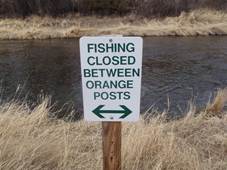
Closure sign by Eva's Hut
Closure Notes: For reasons above and the rainbows population decline due to Whirling Disease in the past, DePuy's closes two apparent and biggest spawning areas: around Eva's Hut and Betty's Riffle. Closure starts in the middle of March and lasts till early June (meanwhile Yellowstone Cutthroat come into creek for spawning as they are also tributary-spawners). I have seen several anglers, sometimes even guides with clients, deliberately fish those two closed areas when nobody seems to be around (except for me as I am stealthy). That's essentially poaching. I don't mind warning them and bringing what I see up to owners. In the fall and winter during browns' spawning runs, that's a different story. As discussed above, browns spawning habitats are different. Then during cold days, only a few die-hard local anglers with Winter Passes are fishing. It's normal that more people visit to fish as weather warms up. Some of those poachers' actions are simply unfair to other anglers at the creek. Regardless of ethic, moral, or theory, just follow the rule at the creek and stay away from closed areas!!
Where to Fish: This doesn't mean our fishing methods and spots are limited. As described above, there are more rainbows coming in than browns in the fall and they scatter and make redds anywhere other than closed areas. This is why I explore and observe anywhere along 3-miles of the creek in the fall and winter while browns are present. I would take notes and pictures where I observe groups of browns. It could be a group of only a few browns in the fall but coming spring, I might see more rainbows gathering at the same spot.
Basic Tactics: As discussed in PART 4, rainbows also make redds and start to mate where pea-sized gravel is on the bottom, topped with shallow and moderate riffles. Trout spotted there can be taken by bouncing streamers, large soft-hackles, or nymphs (eggs) right in front of them. Then always look for deep runs and holes and search there thoroughly with nymph or streamer rigs. As in the fall, I look for large trout in prespawning mode. But once spawning is on, I don't bother trout that are actually digging redds and mating even out of closed area. In my personal observation and notes, when rainbows are holding and ready to spawn, they seem less inclined to bite on large objects passing in front of them, compared to browns, so they often end up getting snagged on their fins or bellies. That's really painful to both trout and anglers. Please follow your sportsmanship and pursuit of technicality.
Flies: Flies introduced in PART 4 are back into my boxes. Here are another set of must-haves.
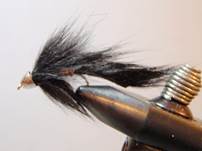 |
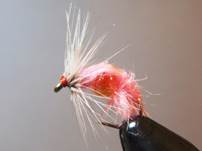
|
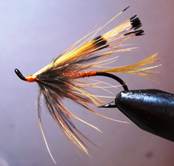
|
Barr's Slumpbuster - Mini & Black
Hook: Dai-Riki 280 size 8, 10, 12
Thread: Black 6/0
Cone: Silver small
Tail/back/collar: Black pine squirrel strip
Ribbing: Fine wire – gold or silver
Belly: Sparkle Braid or Ice dubbing (copper, silver, etc.) |
Yamamoto's SCEGG – Pink
Hook: Dai-Riki 135, MFC 7045 size 10 & 12
Thread: Red 6/0
Bead: Hot orange from craft stores
Back: Pearl Tinsel, large
Body: Ostrich herl, pink
Hackle: Dun hen cape |
Yamamoto's COYOTE – Version 2 (Double Pheasant Soft Hackle)
Hook: Up-eye salmon hook size 8
Thread: UTC 140 Burnt Orange
Tail: Golden pheasant crest
Body: Built-up & tapered thread body
Ribbing: Lagartun French Tinsel Fine
Thorax: Ringneck Pheasant Aftershaft
Hackle: Rooster Ringneck Pheasant Ramp
Wing: Golden Pheasant Tippets |
John Barr's creation was successfully adapted into spring-creek version. I can't emphasize how effective this tiny streamer can be. It's also simple to tie. |
This is the ultimate combination of scud and egg patterns (hence the name). It's designed for durability against vicious bites of big rainbows. |
Fishing for spawning trout in tributaries can be a smaller scale of steelhead fishing. I evolved my original COYOTE into bolder and brighter silhouette. |
Chapters dedicated for streamers, large soft-hackles, and nymphs (list of flies and effective methods) will follow soon.
Satoshi Yamamoto, http://leftyangler.blogspot.com, brought his passion for fly-fishing and fly-tying from Japan to Montana and became the first ever Japanese guide in Livingston, MT. He guides and fish's big rivers like the Madison, the Yellowstone, the spring creeks in Paradise Valley, and various waters in Yellowstone Park. With his Regal Vise at the bench, his fly tying interests vary from tiny midges to 5-inch streamers and anything in between. Once his ideas are combined he goes out for experiments at those near-by waters. Satoshi submits his innovative patterns to Montana Fly Company (www.montanafly.com).
His own innovative original patterns can be purchased from his fly-shop, http://leftytyer.blogspot.com.
| Sysadmin Note |
| Part 7 can be found here |
Comment on this article
Archive of the Eye of the guide






